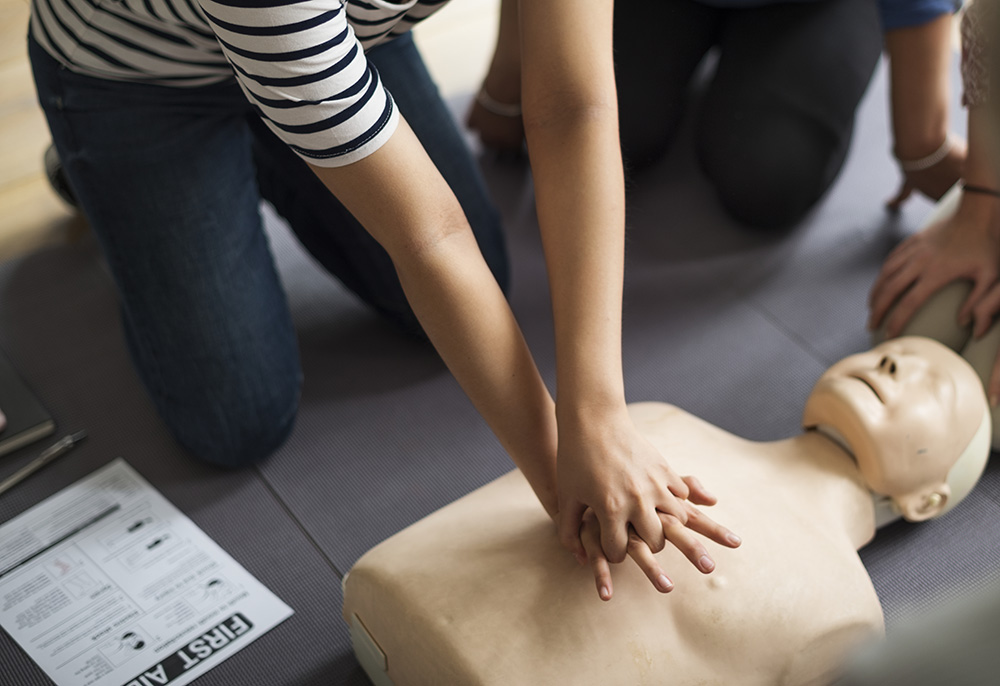By administering immediate care during an emergency, you can help an ill/injured client before emergency medical services (EMS) arrive on site, and you may be able to save a life. At times, even after attending First Aid/CPR training – it can be difficult to remember the steps in providing care, especially during an emergency situation.
The following guide was created to remind you of the necessary steps to take in an emergency situation that requires First Aid and/or CPR.
As a reminder, if you find yourself in an emergency situation and are feeling uncomfortable or unsure about administering First Aid and/or CPR to an ill/injured client, please call EMS @ 911 immediately and report the incident to Circle of Care office after speaking to the 911 operator. You should also remain in the client’s home until emergency services have arrived.
Steps to Administer First Aid
- #1 Check the client to see if they are responsive. Does the client want your help? If the client is unable to answer you, assume you have their permission to administer First Aid.
- #2 Check the client’s ABC’s (Airway, Breathing, Circulation)
- #3 If the client is responsive, ask if there is a need to call EMS (911). If the client is not responsive, call EMS @ 911.
- #4 Care for life-threatening conditions first. Provide the care that is needed, within the scope of your knowledge and training.
- # 5 Wait for EMS to show up (if they were called). Report the incident to Circle of Care.
Protocols and Considerations during COVID-19
Providing First Aid during the COVID-19 pandemic can raise questions about safety and infectious disease transmission. Outlined below are the first aid protocols that should be followed when attending to an ill/injured client:
- Proper use of PPE is extremely important; improper use could potentially increase the risk of infection transmission, especially when providing first aid care.
- For general first aid care, it is recommended to wear a surgical mask, gloves and eye protection.
- All contaminated PPE must be properly disposed of in the garbage (not recycle bin) after use.
- It is important to practice proper hand hygiene after each interaction with the ill/injured client.
- If the ill/injured client is able to tolerate a face covering, offer a surgical mask when providing first aid care.
- Before every home visit, you should be completing a COVID-19 screener on your client to determine if your client have been experiencing any COVID-19 symptoms.
Steps to Administer CPR
- #1 Check the client and their ABC’s (Airway, Breathing, Circulation).
- #2 If the client is unresponsive and/or not breathing properly, call EMS @ 911.
- #3 Place both of your hands on the centre of the client’s chest. Do 30 chest compressions. Push deeply and steadily.
- #4 Open the airway by tilting the client’s head back, and lifting the chin. Give 2 breaths.
- #5 Repeat cycles of 30 chest compressions and 2 breaths. Continue providing CPR until EMS arrives on site. Call Circle of Care to report the incident.
Protocols and Considerations during COVID-19
Providing CPR during the COVID-19 pandemic can raise questions about safety and infectious disease transmission. Outlined below are the first aid protocols that should be followed when attending to an ill/injured client:
- If the ill/injured client requires resuscitation, and you, the First Aider, is concerned that the person may have had COVID-19 symptoms, it is at your discretion whether to perform or not perform mouth-to-mouth breaths based on your personal risk threshold.
- If you, the First Aider, choose to perform breaths, you should use a barrier device, such as a pocket mask, to minimize the risks of infectious transmissions.
- If you, the First Aider, do not have access to a barrier mask, or has concerns that the ill/injured client has COVID-19, you should perform compressions only and no breaths until the emergency medical services (EMS) arrive.
- When performing hands-only CPR, the First Aider should lay a cloth, towel or clothing over the ill/injured client’s mouth and nose to prevent any potentially contagious particles from escaping into the air during chest compressions, and then should push hard and fast in the centre of the ill/injured client’s chest until emergency medical services arrives.
- If you, the First Aider, believe the ill/injured client may have COVID-19, you should state your concerns to the 911 telephone operator so that all responders can be aware of the potential for COVID-19 transmission.
Future CPR Sessions:
Circle of Care is currently in the process of confirming CPR re-certification training dates for September, and as soon as more training sessions become available, you will be notified so that you can register.
Additional First Aid/CPR Resources
First Aid App from the Canadian Red Cross
The official Canadian Red Cross First Aid app puts lifesaving advice in your hands. Available for Apple and Android mobile devices, the app helps you maintain your first aid skills and respond to everyday emergencies. By downloading the app on your smartphone or tablet, you get instant access to videos, interactive quizzes and simple step-by-step advice to help you maintain your life-saving skills and respond when needed. Download the app to keep lifesaving help in your hands.

